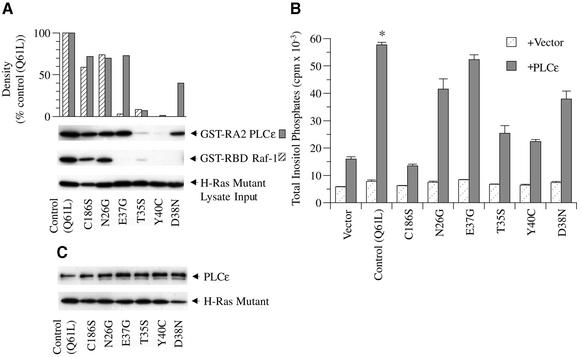Fig. 8. Effect of specific Ras mutations on binding to the RA2 domain of PLCε and activation of PLC activity. (A) Ras mutant binding to the RA2 domain of PLCε and RBD of Raf-1. Site-directed mutagenesis was used to introduce the indicated mutations into constitutively active Q61L H-Ras (pRSV-Leu61). COS-7 cell lysates overexpressing each mutant (input; bottom arrow) were incubated with GST fusion proteins to the RA2 domain of PLCε (GST–RA2 PLCε; top arrow) and the RBD of Raf-1 (GST–RBD Raf-1; middle arrow). Ras binding and GST pull-down assay were performed as detailed in Figure 3 and Materials and methods. An image of an autoradiograph of a western blot stained with anti-Ras is shown. Autoradiographs were quantitated by densitometry and are shown in the top panel. (B) Regulation of PLCε activity by H-Ras mutants. COS-7 cells were transiently transfected with 0.5 µg of vector (pRSV-LacZ), Q61L H-Ras (pRSV-Leu61) or the indicated mutant and vector (pCMV-LacZ) or rat PLCε (pCMV-PLCε-FLAG). Values are the mean ± SEM of five experiments performed in duplicate. *P at least <0.05 compared with stimulation of PLCε with each Ras mutant except E37G. (C) Expression of PLCε and H-Ras mutants. A western blot was stained concurrently with anti-FLAG (PLCε; arrow) and anti-Ras (Q61L H-Ras; arrow). The blot is representative of three similar experiments.

An official website of the United States government
Here's how you know
Official websites use .gov
A
.gov website belongs to an official
government organization in the United States.
Secure .gov websites use HTTPS
A lock (
) or https:// means you've safely
connected to the .gov website. Share sensitive
information only on official, secure websites.
